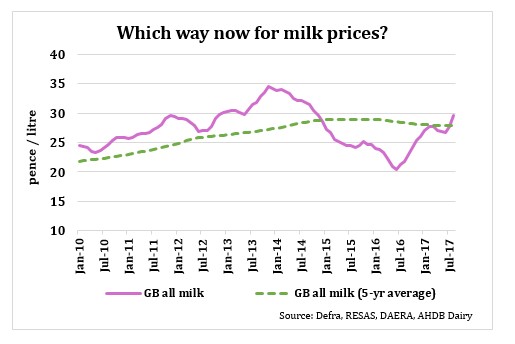
for you and your business
☰ Menu
- Home
- About
- People
- Services
- International
- Contact
- Work with us
- Blog
- Testimonials
- Resources & Downloads
- Videos
- Newsletters
UK dairy processor Muller has increased its standard non-aligned milk price by 0.5p/litre. The rise means the 700 Muller Direct producers will receive 30.5p/litre on its liquid contract with constituents of 4% butterfat and 3.3% protein. (Farmers Weekly: October 2017).
 With break-even prices in the region of 31-32ppl this is good news, but is this a trend that we can expect to continue? There is now, a free market for milk, and the prices are driven by global demand rather than just the UK. We have seen the fall in the value of the pound having a positive effect on milk prices.
With break-even prices in the region of 31-32ppl this is good news, but is this a trend that we can expect to continue? There is now, a free market for milk, and the prices are driven by global demand rather than just the UK. We have seen the fall in the value of the pound having a positive effect on milk prices.
With break-even prices in the region of 31-32ppl this is good news, but is this a trend that we can expect to continue? There is now, a free market for milk, and the prices are driven by global demand rather than just the UK. We have seen the fall in the value of the pound having a positive effect on milk prices.
Some commentators are predicting that dairy prices worldwide may have peaked. Rabobank’s latest quarterly report on the global dairy market, states higher farmgate milk prices have encouraged producers to increase supply and so key exporting regions are showing signs of increasing milk production. Muller’s price has now increased by a third compared with the same month in 2016. Whilst markets are well balanced, an increase in supply would cause the trend to falter and we might see a drop in Q1 2018.
The Global Dairy Trade (GDT) price index fell 2.4% in the first online auction of October 2017, which is the biggest change of direction since May of this year, according to the AHDB. One auction of course does not mark the end of price rises.
So, what to do: Always difficult but price levels are outside the control of individual farmers, and so the focus has to be on sustained cost control. Perhaps one area to focus on is, if possible, the repayment of debt which may have been taken on in the last downturn. If that is not possible, then inflation having hit its highest level since April 2012 debt at variable rates, it may be appropriate to fix interest rates.